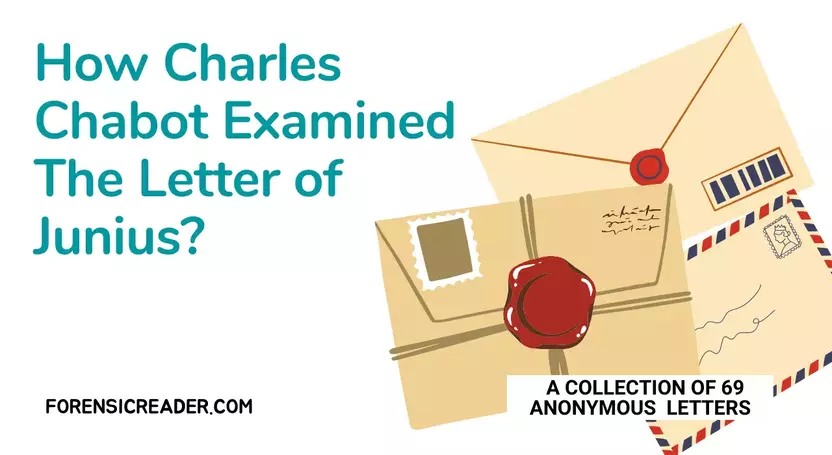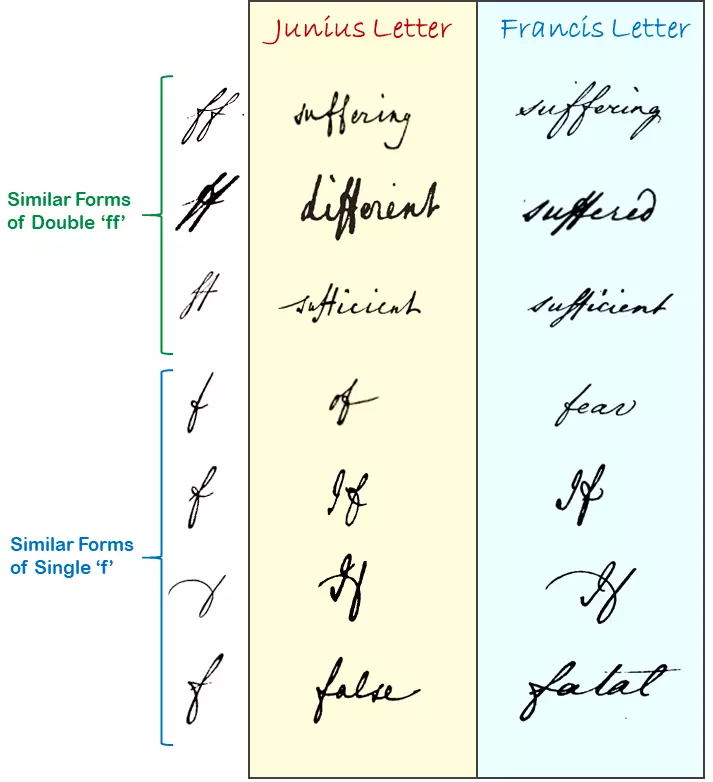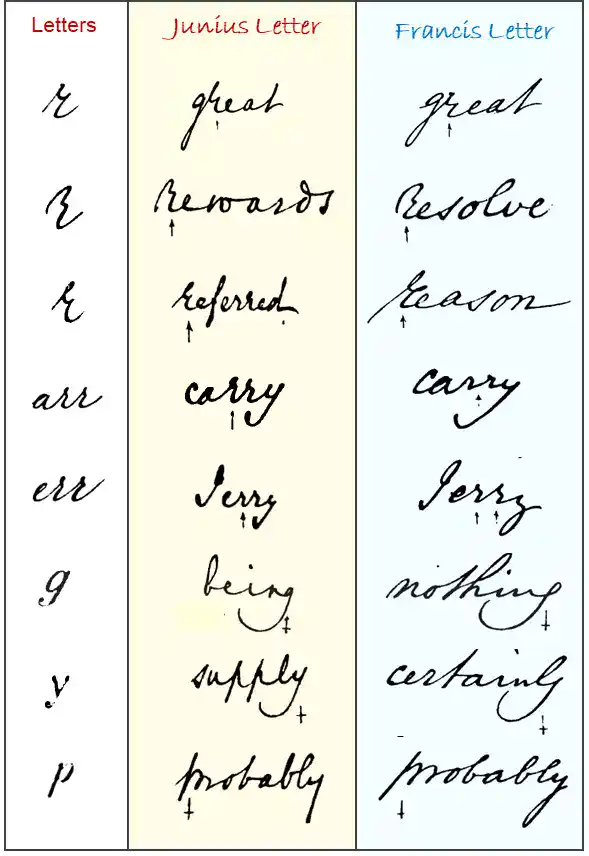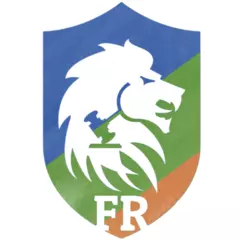One of the most famous and called to be the stepping stone for forensic questioned document development is the case of “Letters of Junius.” The case itself is said to be the most widely publicized case in 18th-century England.
And with this post, I try to come up with a newer approach and try to emphasize how Charles Chabot approaches the comparison of the standard Junius letter sample with the Sir Philip Francis samples.
Case History of The Letter of Junius
It all began in the late 1770s, with the publishing of 69 letters. 29 of them were intended to be published publicly for newspaper readers. And the rest of the 40 were of private conversation, which was later made public.
These letters were published in two major London newspapers named Public Advertiser and London Evening Post on several dates from January 21, 1769, to January 21, 1772.
Why they are known as Letters of Junius?
Because of the signatures. The first dozen of letters were signed under the name “Junius.” That’s why this collection of letters is called “Letter of Junius”. However, the collection also had additional signed names. One common one was “Brutus” and another was “Lucius.”
Another reason: The Woodfall edition included “Dedication to English Nation” which was published in 1772, strongly inclined the penmanship to be Junius. It was because, in the Preface section, Junius grants Henry Sampson Woodfall full ownership and copyright of the letters.
So, Why this was widely publicized case of 18th century?
Actually, the majority of these letters have critics of King George III’s government. It’s more about what was happening in the government, particularly in parliament. Their important conversation, debating, and many other secret discussions that no government wants to get out in front of the public.
So, when they all get published, the government buckle-up in finding the real penmanship of these letters. Many penmanship experts were called. But the most influential work was done by Mr. Charles Chabot.
Charles Chabot was an Englishman lithographer who has done quite well work in revocation and development as general expert handwriting. All the initial inspection points on Sir Philip Francis however nothing can be proven true in a court of law. And Chabot pronounced an opinion that there was insufficient evidence to justify any conclusive result.
Meanwhile, Woodfall was also eliminated from the possible writer’s list and labeled with a charge of “guilty of printing and publishing only.” The debate of finding the real penmanship of Letter of Junius continues to a century which reveals 40+ possible authors for these letters.
Possible Penmanships (Writers) of “Letter of Junius”
The following are the 20 possible writers for the Letter of Junius case. However, there were 40+ possible writers which are listed in the 1855 editions of Junius by John Wade.
| S.No. | Possible Penmanship | S.No. | Possible Penmanship |
| 1 | Hugh Macaulay Boyd | 11 | Richard Glover |
| 2 | Edmund Burke | 12 | Henry Grattan |
| 3 | William Burke | 13 | Sir William Jones |
| 4 | John Butler | 14 | Charles Lee |
| 5 | Charles Wolfram Cornwall | 15 | Charles Lloyd |
| 6 | Sir Philip Francis | 16 | Jean-Louis de Lolme |
| 7 | Edward Gibbon | 17 | Thomas Pownall |
| 8 | George Grenville | 18 | Philip Rosenhagen |
| 9 | William Gerard Hamilton | 19 | John Horne Tooke |
| 10 | William Greatrakes | 20 | Daniel Wray |
How Charles Chabot Examined Junius Letters?

Samples Used: Samples used by Chabot were not regularly papered questioned documents. All the letters were in the form of plates. Both questioned and reference samples.
I am going to state the comparison report that was made by Chabot with the reference letter samples of Sir Philip Francis (who is called to the most suspected writer for these Junius letters).
Apart from this, there were other suspects too that had other comparison samples. You can learn more about them in a book of Handwriting of Junius book.
Examination of Paper Itself
On analysis of minute characteristics of paper, Chabot finds similarities between the Francis letter and the 1st Junius letter that was published on February 6, 1768. Following are some similarities:
- Color
- Texture
- Thickness
- Paper Watermark
- Water-lines, not quite parallel and of same width apart.
- Two sheets of paper are so exactly of the same size and shape, cuts out same
- Slightly different top and bottom margin
And this also seems similar in the case of the ink.
- Ink color of two letter were same
- Thin inks lines: pale brown color
- Dark lines: quite black
With the paper examination of both letters from Sir Philips Francis and Junius, he opined that papers were probably originated from the same frame and paper factory. But this was not alone enough to hold Philips behind the bars permanently (which never happens).
Examination of Letter Content and Writing
So, what letter properties that make Sir Philip Francis first suspect? Let’s find out.
For the shake of simplicity. I divided the handwriting analysis by Chabot into two parts; (1) w.r.t. formation of the letter and connecting strokes, (2) habit and natural variation in handwriting.
Part 1: Letter Formation and Connecting Strokes
A. Formation of Letter ‘d’
Small letter ‘d’: Both letters had curled form of alphabet ‘d’. They were seen majorly when the ending letter is ‘d’ along with the natural variations.
Some of the most highlighted pointers by handwriting examination were their considerable variety in their formation.

Both the letters also have some similarities in the ending curl of ‘d’ with considerably the same pen pressure.

B. Formation of ‘f’
Common three formations of double ff and seven different variations of single ‘f’. There is a lot of variability with the ‘f’ letter formation. The most common double ‘ff’ crosses those letters, in a complexion manner forming a relatively large loop. Here it is.

C. Formation of ‘k’
In the Junius letter, some smaller letter ‘k’ was properly made, some were looped, straight, and with different ending strokes. In many instances, Chabot finds that the Junius letter was carefully made to imply Francis’s writing. Following are some observations from the book.

D. Formation of Other Small Letter and their Connections
Some other small letters that were examined and analyzed are given below.

Part 2: Common Habits While Writing
Following were the common variations that are seen in both letters i.e. Sir Philips Francis and Junius Letters. The most highlighted ones were the mode of dating Letters and placing full stops

Apart from this, the following are some natural habits of writing that were seen:
- Signing initials between two dashes
- Paragraph spaces and alignment
- Excellent punctuation and abbreviation skills
- Enlargement of first alphabet in words
- Similarities in correction, misspelled and miswriting words
Charles Chabot Report on Letter of Junius
Though there are many similarities that Chabot reported. In his report, he can’t conclude that writing was of Francis because of insufficient evidence. Plus, he also finds the sign of adopted writing (trying to coping feature from original and practices to make it appear legit) and deliberately dark and abrupt ending. However, his opinion about the papers that were used to make letters was originated from the same factory.
This is just a glimpse of the book that I majorly referred to build this article. The book is 723 pages and the best part is it is Free. I suggest if you really want to read it more check the book from the reference.
Lastly, with the recent advances in technology, the computer-based examination was made possible that was first conducted by Alvar Ellegård. This gives a statistical observation towards the possibility of the writer. You can read more about him from here.
Reference:
- The Handwriting of Junius, Professionally Investigated by Mr. Charles Chabot Expert [Book]
- Reviewed Work: The Letters of Junius. Oxford, Oxford University Press 1978 by John Cannon [Source]
- Who was Junius?: notes and observations upon the letters of Junius. (pp. 1–36) [Source]
- Junius Letter: 1855 edition by John Wade
Continue Reading:
- How to Remove Fingerprints from Paper? Is it Possible? Forensic Expert Answer
- 14 Myths of Fingerprints And Questioned Documents: A Forensic Study
- Can a Watermark on Paper be Forged? Prevention and Detection
- Forensic Examination of Genuine Watermarks on Questioned Documents
- Home Evasion Forensic File Case: Jonathan Binney Killer and Judy Southern Victim

FR Author Group at ForensicReader is a team of Forensic experts and scholars having B.Sc, M.Sc, or Doctorate( Ph.D.) degrees in Forensic Science. We published on topics on fingerprints, questioned documents, forensic medicine, toxicology, physical evidence, and related case studies. Know More.
